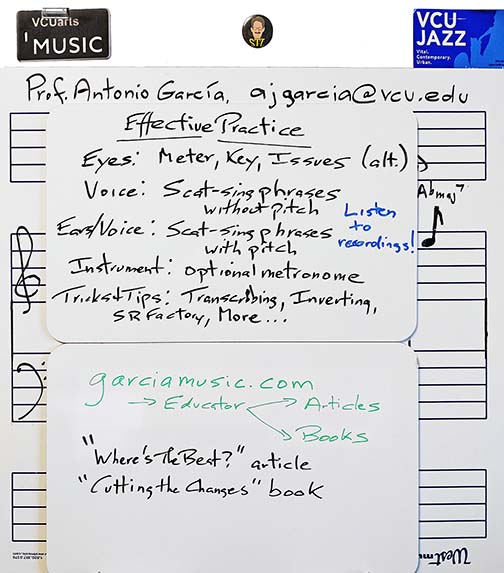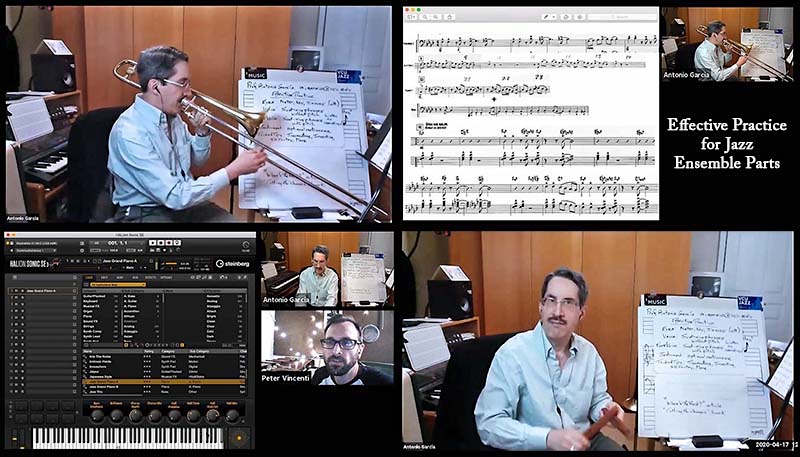_ _ _ _ _ _ _ _ _ _ _ _ _ _ _
Antonio J. García is a Professor Emeritus and former Director of
Jazz Studies at Virginia Commonwealth University, where he directed the Jazz
Orchestra I; instructed Applied Jazz Trombone, Small Jazz Ensemble, Jazz Pedagogy, Music
Industry, and various jazz courses; founded a B.A. Music Business Emphasis (for
which he initially served as Coordinator); and directed the Greater Richmond
High School Jazz Band. An alumnus of the Eastman School of Music and of Loyola
University of the South, he has received commissions for jazz, symphonic,
chamber, film, and solo works—instrumental and vocal—including
grants from Meet The Composer, The Commission Project, The Thelonious Monk
Institute, and regional arts councils. His music has aired internationally and
has been performed by such artists as Sheila Jordan, Arturo Sandoval, Jim Pugh,
Denis DiBlasio, James Moody, and Nick Brignola. Composition/arrangement honors
include IAJE (jazz band), ASCAP (orchestral), and Billboard Magazine (pop
songwriting). His works have been published by Kjos Music, Hal Leonard, Kendor
Music, Doug Beach Music, ejazzlines, Walrus, UNC Jazz Press, Three-Two Music
Publications, Potenza Music, and his own garciamusic.com, with five recorded on CDs by Rob
Parton’s JazzTech Big Band (Sea Breeze and ROPA JAZZ). His scores for
independent films have screened across the U.S. and in Italy, Macedonia, Uganda, Australia, Colombia, India, Germany, Brazil, Hong Kong, Mexico, Israel, Taiwan, and the United Kingdom. One of his recent commissions was performed at Carnegie Hall by the Orpheus Chamber Orchestra.
A Conn-Selmer trombone clinician, Mr. García serves as the
jazz clinician for The Conn-Selmer Institute. He has freelanced as trombonist,
bass trombonist, or pianist with over 70 nationally renowned artists, including
Ella Fitzgerald, George Shearing, Mel Tormé, Doc Severinsen, Louie Bellson, Dave
Brubeck, and Phil Collins—and has performed at the Montreux, Nice, North
Sea, Pori (Finland), New Orleans, and Chicago Jazz Festivals. He has produced
recordings or broadcasts of such artists as Wynton Marsalis, Jim Pugh, Dave
Taylor, Susannah McCorkle, Sir Roland Hanna, and the JazzTech Big Band and is
the bass trombonist on Phil Collins’ CD “A Hot Night
in Paris” (Atlantic) and DVD “Phil Collins:
Finally...The First Farewell Tour” (Warner Music). An avid scat-singer,
he has performed vocally with jazz bands, jazz choirs, and computer-generated
sounds. He is also a member of the National Academy of Recording Arts &
Sciences (NARAS). A New Orleans native, he also performed there with such local
artists as Pete Fountain, Ronnie Kole, Irma Thomas, and Al Hirt.
Most of all, Tony is dedicated to assisting musicians towards finding their joy. His 35-year full-time teaching career and countless residencies in schools have touched tens of thousands of students in Canada, Europe, South Africa, Australia, The Middle East, and across the U.S. His collaborations highlighting jazz and social justice have raised hundreds of thousands of dollars, providing education to students and financial support to African American, Latinx, LGBTQ+, and Veterans communities, children’s medical aid, and women in jazz. He serves as a Research Faculty Member at the University of KwaZulu-Natal. His partnerships with South Africa focusing on racism and healing resulted in his performing at the Nelson Mandela National Memorial Service in D.C. in 2013. He also fundraised $5.5 million in external gift pledges for the VCU Jazz Program.
Mr. García is the Past Associate Jazz Editor of the International Trombone Association Journal.
He has served as a Network Expert (for Improvisation Materials), President’s Advisory Council member, and
Editorial Advisory Board member for the Jazz
Education Network . His newest book, Jazz Improvisation: Practical Approaches to Grading (Meredith Music), explores avenues for creating structures that correspond to course objectives. His
book Cutting the Changes: Jazz
Improvisation via Key Centers (Kjos Music) offers musicians of all ages the
opportunity to improvise over standard tunes using just their major scales. He
is Co-Editor and Contributing Author of Teaching
Jazz: A Course of Study (published by NAfME), authored a chapter within Rehearsing The Jazz Band and The Jazzer’s Cookbook (published by
Meredith Music), and contributed to Peter Erskine and Dave Black’s The Musician's Lifeline (Alfred). Within the International Association for Jazz Education he
served as Editor of the Jazz Education
Journal, President of IAJE-IL, International Co-Chair for Curriculum and
for Vocal/Instrumental Integration, and Chicago Host Coordinator for the 1997
Conference. He served on the Illinois Coalition for Music Education
coordinating committee, worked with the Illinois and Chicago Public Schools to
develop standards for multi-cultural music education, and received a curricular
grant from the Council for Basic Education. He has also served as Director of
IMEA’s All-State Jazz Choir and Combo and of similar ensembles outside of
Illinois. He is the only individual to have directed all three genres of Illinois All-State jazz ensembles—combo, vocal jazz choir, and big band—and is the recipient of the Illinois Music Educators Association’s 2001 Distinguished Service Award.
Regarding Jazz Improvisation: Practical Approaches to Grading, Darius Brubeck says, "How one grades turns out to be a contentious philosophical problem with a surprisingly wide spectrum of responses. García has produced a lucidly written, probing, analytical, and ultimately practical resource for professional jazz educators, replete with valuable ideas, advice, and copious references." Jamey Aebersold offers, "This book should be mandatory reading for all graduating music ed students." Janis Stockhouse states, "Groundbreaking. The comprehensive amount of material García has gathered from leaders in jazz education is impressive in itself. Plus, the veteran educator then presents his own synthesis of the material into a method of teaching and evaluating jazz improvisation that is fresh, practical, and inspiring!" And Dr. Ron McCurdy suggests, "This method will aid in the quality of teaching and learning of jazz improvisation worldwide."
About Cutting the Changes, saxophonist David Liebman states, “This book is
perfect for the beginning to intermediate improviser who may be daunted by the
multitude of chord changes found in most standard material. Here is a path
through the technical chord-change jungle.” Says vocalist Sunny Wilkinson,
“The concept is simple, the explanation detailed, the rewards immediate. It’s
very singer-friendly.” Adds jazz-education legend Jamey Aebersold, “Tony’s
wealth of jazz knowledge allows you to understand and apply his concepts
without having to know a lot of theory and harmony. Cutting the Changes allows music educators to
present jazz improvisation to many students who would normally be scared of
trying.”
Of his jazz curricular work, Standard of Excellence states: “Antonio García has developed a
series of Scope and Sequence of Instruction charts to provide a structure that
will ensure academic integrity in jazz education.” Wynton Marsalis emphasizes:
“Eight key categories meet the challenge of teaching what is historically an
oral and aural tradition. All are important ingredients in the recipe.” The Chicago Tribune has highlighted García’s
“splendid solos...virtuosity and musicianship...ingenious scoring...shrewd
arrangements...exotic orchestral colors, witty riffs, and gloriously
uninhibited splashes of dissonance...translucent textures and elegant voicing”
and cited him as “a nationally noted jazz artist/educator...one of the most
prominent young music educators in the country.” Down Beat has recognized his “knowing solo work on trombone” and
“first-class writing of special interest.” The
Jazz Report has written about the “talented trombonist,” and Cadence noted his “hauntingly lovely”
composing as well as CD production “recommended without any qualifications
whatsoever.” Phil Collins has said simply, “He can be in my band whenever he
wants.” García is also the subject of an extensive interview within Bonanza: Insights and Wisdom from
Professional Jazz Trombonists (Advance Music), profiled along with such
artists as Bill Watrous, Mike Davis, Bill Reichenbach, Wayne Andre, John
Fedchock, Conrad Herwig, Steve Turre, Jim Pugh, and Ed Neumeister.
Tony is the Secretary of the Board of The Midwest Clinic and a past Advisory Board member of the Brubeck Institute. The partnership he created between
VCU Jazz and the Centre for Jazz and Popular Music at the University of
KwaZulu-Natal merited the 2013 VCU Community Engagement Award for Research. He
has served as adjudicator for the International Trombone Association’s Frank
Rosolino, Carl Fontana, and Rath Jazz Trombone Scholarship competitions and the
Kai Winding Jazz Trombone Ensemble competition and has been asked to serve on
Arts Midwest’s “Midwest Jazz Masters” panel and the Virginia Commission for the
Arts “Artist Fellowship in Music Composition” panel. He was published within the inaugural edition of Jazz Education in Research and Practice and has been repeatedly
published in Down Beat; JAZZed; Jazz
Improv; Music, Inc.; The
International Musician; The
Instrumentalist; and the journals of NAfME, IAJE, ITA, American
Orff-Schulwerk Association, Percussive Arts Society, Arts Midwest, Illinois
Music Educators Association, and Illinois Association of School Boards.
Previous to VCU, he served as Associate Professor and Coordinator of Combos at
Northwestern University, where he taught jazz and integrated arts, was Jazz
Coordinator for the National High School Music Institute, and for four years
directed the Vocal Jazz Ensemble. Formerly the Coordinator of Jazz Studies at
Northern Illinois University, he was selected by students and faculty there as
the recipient of a 1992 “Excellence in Undergraduate Teaching” award and
nominated as its candidate for 1992 CASE “U.S. Professor of the Year” (one of
434 nationwide). He is recipient of the VCU School of the Arts’ 2015 Faculty Award of Excellence for his teaching, research, and service, in 2021 was inducted into the Conn-Selmer Institute Hall of Fame, and is a 2023 recipient of The Midwest Clinic's Medal of Honor. Visit his web site
at <www.garciamusic.com>.
If you entered this page via a
search engine and would like to visit more of this site, please
click | Home
|.

